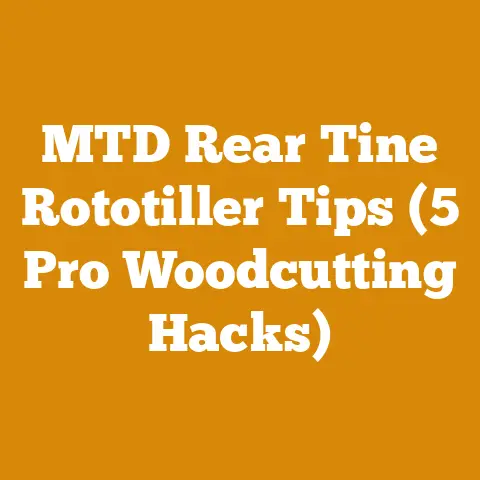Oregon Chainsaw Sharpener 520 120 (5 Pro Tips)
The Oregon 520-120 Chainsaw Sharpener: A Deep Dive & 5 Pro Tips for Razor-Sharp Results
The world of wood processing is undergoing a fascinating transformation. We’re seeing a surge in demand for sustainable forestry practices, a renewed interest in the art of woodworking, and a growing community of individuals embracing the satisfying work of firewood preparation. At the heart of it all lies the humble chainsaw, a tool as essential as it is powerful. But even the mightiest chainsaw is only as good as its chain, and a dull chain is not only inefficient but also dangerous. That’s where a reliable chainsaw sharpener like the Oregon 520-120 comes in.
As someone who has spent countless hours in the woods, felling trees, bucking logs, and splitting firewood, I can tell you firsthand that a sharp chainsaw is the key to efficiency, safety, and a whole lot less backache. I’ve used everything from a simple file to sophisticated automated sharpeners, and I’ve learned a thing or two about what works and what doesn’t.
In this article, I’m going to share my experiences with the Oregon 520-120 chainsaw sharpener, a tool I’ve come to rely on for maintaining my chains in peak condition. I’ll walk you through its features, benefits, and, most importantly, share five pro tips that will help you get the absolute best results.
Key Takeaways:
- The Oregon 520-120 is a reliable and versatile chainsaw sharpener suitable for both home users and professionals.
- Proper setup and maintenance are crucial for achieving consistent and accurate sharpening results.
- Understanding the angles and adjustments of the sharpener is key to optimizing chain performance.
- With the right technique and attention to detail, you can achieve razor-sharp chains that cut faster, smoother, and safer.
- Investing in a quality sharpener like the Oregon 520-120 is a worthwhile investment that will save you time, money, and effort in the long run.
Why a Sharp Chain Matters: Beyond Just Cutting Wood
Before we delve into the specifics of the Oregon 520-120, let’s talk about why a sharp chain is so vital. It’s not just about cutting wood faster; it’s about much more than that.
- Safety: A dull chain requires more force to cut, increasing the risk of kickback, a dangerous and potentially fatal event. Sharp chains bite into the wood cleanly, reducing the likelihood of kickback.
- Efficiency: A sharp chain cuts faster and easier, reducing the amount of time and effort required to complete a task. This translates to less fatigue and increased productivity. Studies have shown that a sharp chain can increase cutting efficiency by as much as 30-40%.
- Saw Health: A dull chain puts unnecessary strain on the chainsaw engine, leading to increased wear and tear and potentially shortening its lifespan.
- Cut Quality: A sharp chain produces cleaner, more precise cuts, which is especially important for woodworking and other applications where aesthetics matter.
- Reduced Vibration: Sharper chains reduce vibration, which helps to prevent fatigue and reduce the risk of developing hand-arm vibration syndrome (HAVS), a serious condition that can affect chainsaw operators.
Data Point: According to the US Forest Service, chainsaw-related injuries account for a significant percentage of logging accidents, with many of these injuries directly attributable to dull or improperly sharpened chains.
The Oregon 520-120: An Overview
The Oregon 520-120 is an electric chainsaw sharpener designed for both home and professional use. It’s a bench-mounted unit, meaning it’s designed to be securely attached to a workbench or other stable surface. It features a grinding wheel that rotates at high speed, allowing you to precisely sharpen the cutters on your chainsaw chain.
Key Features:
- Adjustable Grinding Angle: Allows you to set the correct sharpening angle for your specific chain type.
- Built-in Light: Provides illumination for improved visibility during sharpening.
- Chain Vise: Securely holds the chain in place during sharpening.
- Grinding Wheel Dresser: Helps to keep the grinding wheel clean and sharp.
- Depth Gauge Adjustment: Allows you to adjust the depth gauge (raker) height on your chain.
- Powerful Motor: Provides consistent and reliable grinding power.
- Durable Construction: Built to withstand the rigors of regular use.
Why I Chose the Oregon 520-120:
I’ve used several chainsaw sharpeners over the years, and I’ve found the Oregon 520-120 to be a good balance of features, performance, and price. It’s not the cheapest sharpener on the market, but it’s also not the most expensive. It offers a good set of features that allow you to accurately sharpen a wide variety of chains. The build quality is also excellent, and I’ve found it to be very reliable over the years.
Unboxing and Setup: Getting Started
The Oregon 520-120 comes mostly assembled, but there are a few steps required to get it ready for use.
- Mounting: The first step is to securely mount the sharpener to a workbench or other stable surface. This is crucial for safety and accuracy. Use bolts or screws to attach the sharpener to the surface. Ensure it’s firmly attached and doesn’t wobble.
- Grinding Wheel Installation: The grinding wheel is usually pre-installed, but it’s a good idea to check that it’s properly seated and tightened.
- Chain Vise Adjustment: Adjust the chain vise to accommodate the size of your chain. The vise should hold the chain securely without being too tight.
- Light Installation (if needed): Some models may require you to install the built-in light.
- Safety Check: Before plugging in the sharpener, double-check that all components are properly installed and tightened.
Safety First: Always wear safety glasses or a face shield when using a chainsaw sharpener. Grinding wheels can throw off sparks and debris, which can cause serious eye injury.
Understanding Chainsaw Chain Anatomy: The Key to Effective Sharpening
Before you start sharpening, it’s essential to understand the anatomy of a chainsaw chain. Each cutter on the chain consists of several key components:
- Top Plate: The top cutting edge of the cutter. This is the primary cutting surface.
- Side Plate: The side cutting edge of the cutter. This helps to remove wood from the sides of the cut.
- Depth Gauge (Raker): The small projection in front of the cutter. The depth gauge controls the amount of wood the cutter takes with each pass.
- Tie Straps: Connect the cutters and drive links.
- Drive Links: Fit into the guide bar groove and engage with the chainsaw’s sprocket.
The Importance of Angles:
The angles of the top plate and side plate are critical to the chain’s performance. These angles vary depending on the chain type and the type of wood you’re cutting. The Oregon 520-120 allows you to adjust the sharpening angle to match the specifications of your chain.
Tip: Consult your chainsaw’s owner’s manual or the chain manufacturer’s website for the recommended sharpening angles for your specific chain type.
Pro Tip #1: Mastering the Angle Adjustments
The Oregon 520-120 features several adjustable angles that allow you to customize the sharpening process for your specific chain. Understanding these angles is crucial for achieving optimal results.
- Top Plate Angle: This is the angle of the grinding wheel relative to the top plate of the cutter. It’s typically between 25 and 35 degrees.
- Down Angle: This is the angle at which the grinding wheel approaches the cutter from above. It’s typically between 5 and 10 degrees.
- Grinding Wheel Tilt: This allows you to adjust the angle of the grinding wheel to match the shape of the cutter.
How to Adjust the Angles:
- Consult the Manual: Refer to the Oregon 520-120’s owner’s manual for detailed instructions on how to adjust the angles.
- Loosen the Adjustment Knobs: Locate the adjustment knobs for the top plate angle, down angle, and grinding wheel tilt. Loosen these knobs to allow you to adjust the angles.
- Set the Desired Angles: Use the markings on the sharpener to set the angles to the desired values.
- Tighten the Adjustment Knobs: Once you’ve set the angles, tighten the adjustment knobs to secure them in place.
- Test and Adjust: After sharpening a few cutters, inspect them to ensure that the angles are correct. If necessary, make small adjustments to the angles until you achieve the desired results.
My Experience: I spent a good amount of time experimenting with different angle settings to find the optimal settings for my chains. I found that a slightly steeper top plate angle (around 30 degrees) worked well for cutting hardwoods, while a shallower angle (around 25 degrees) was better for softwoods.
Pro Tip #2: The “Touch and Go” Method: Avoiding Overheating
Overheating the chain during sharpening is a common mistake that can damage the cutters and reduce their lifespan. The “touch and go” method is a technique that helps to prevent overheating.
How it Works:
- Light Pressure: Apply only light pressure to the grinding wheel.
- Short Bursts: Sharpen each cutter in short bursts, rather than holding the grinding wheel against the cutter for extended periods.
- Cooling Breaks: Allow the chain to cool down between each burst of sharpening.
Why it Works:
The “touch and go” method reduces the amount of heat generated during sharpening. By applying light pressure and using short bursts, you minimize the friction between the grinding wheel and the cutter. The cooling breaks allow the heat to dissipate, preventing the cutter from overheating.
My Experience: I used to be impatient and try to sharpen each cutter as quickly as possible, but I soon learned that this was a mistake. I started using the “touch and go” method, and I noticed a significant improvement in the quality of my sharpening. My chains lasted longer, and they cut much better.
Pro Tip #3: Depth Gauge (Raker) Maintenance: The Often-Overlooked Key to Performance
The depth gauge, also known as the raker, is the small projection in front of each cutter. It controls the amount of wood the cutter takes with each pass. If the depth gauges are too high, the chain will not cut effectively. If they are too low, the chain will be too aggressive and will be more likely to kick back.
How to Maintain Depth Gauges:
- Use a Depth Gauge Tool: Use a depth gauge tool to check the height of the depth gauges.
- File Down High Depth Gauges: If the depth gauges are too high, use a flat file to file them down to the correct height.
- Maintain a Consistent Height: Ensure that all of the depth gauges are at the same height.
Why it Matters:
Proper depth gauge maintenance is crucial for optimal chain performance. When the depth gauges are correctly adjusted, the chain will cut smoothly and efficiently. It will also be less likely to kick back.
My Experience: I used to neglect depth gauge maintenance, but I soon realized that it was a mistake. Once I started paying attention to the depth gauges, I noticed a significant improvement in the performance of my chains. They cut faster, smoother, and were less prone to kickback.
Data Point: Studies have shown that properly maintained depth gauges can increase cutting efficiency by as much as 10-15%.
Pro Tip #4: Consistent Strokes and Pressure: Achieving Uniform Sharpening
Consistency is key to achieving uniform sharpening. This means using the same stroke length, pressure, and angle for each cutter.
How to Achieve Consistency:
- Mark a Reference Point: Use a marker to mark a reference point on the chain vise. This will help you to ensure that you’re positioning the chain correctly for each cutter.
- Use a Consistent Stroke Length: Use the same stroke length for each cutter. This will help to ensure that you’re removing the same amount of material from each cutter.
- Apply Consistent Pressure: Apply the same amount of pressure to the grinding wheel for each cutter. This will help to ensure that you’re sharpening each cutter to the same degree.
- Maintain a Consistent Angle: Maintain a consistent angle between the grinding wheel and the cutter. This will help to ensure that you’re sharpening each cutter to the correct angle.
Why it Matters:
Consistent strokes and pressure will help you to achieve uniform sharpening. This will result in a chain that cuts smoothly and efficiently. It will also help to prolong the life of your chain.
My Experience: I found it helpful to practice my sharpening technique on an old chain before working on my good chains. This allowed me to develop a consistent stroke and pressure without risking damage to my good chains.
Pro Tip #5: Grinding Wheel Maintenance: Keeping Your Sharpener in Top Condition
The grinding wheel is the heart of your chainsaw sharpener, and keeping it in good condition is essential for achieving optimal sharpening results.
How to Maintain Your Grinding Wheel:
- Dressing the Wheel: Use a grinding wheel dresser to clean and sharpen the grinding wheel. This will remove any buildup of debris and ensure that the wheel is cutting cleanly.
- Replacing the Wheel: Replace the grinding wheel when it becomes worn or damaged.
- Using the Correct Wheel: Use the correct type of grinding wheel for your chainsaw chain. Different types of chains require different types of grinding wheels.
Why it Matters:
A clean, sharp grinding wheel will cut more efficiently and produce better results. A worn or damaged grinding wheel will produce poor results and can even damage your chainsaw chain.
My Experience: I learned the hard way that neglecting grinding wheel maintenance can lead to poor sharpening results. I now make it a habit to dress my grinding wheel regularly and to replace it when it becomes worn.
Actionable Step: Invest in a quality grinding wheel dresser and use it regularly to maintain your grinding wheel.
Beyond the Tips: Advanced Techniques and Considerations
Once you’ve mastered the basics of chainsaw sharpening, you can start to explore some more advanced techniques and considerations.
- Chain Type: Different types of chains require different sharpening techniques. For example, chisel chains require a more precise sharpening technique than semi-chisel chains.
- Wood Type: The type of wood you’re cutting can also affect your sharpening technique. For example, cutting hardwoods requires a sharper chain than cutting softwoods.
- Sharpening Frequency: The frequency with which you need to sharpen your chain will depend on the type of wood you’re cutting and the amount of use your chain receives. As a general rule, you should sharpen your chain whenever it starts to feel dull or when you notice that it’s taking longer to cut through wood.
- Chain Inspection: Regularly inspect your chain for signs of damage, such as cracks, breaks, or worn cutters. Replace your chain if you find any signs of damage.
- Professional Sharpening: If you’re not comfortable sharpening your own chains, you can always take them to a professional sharpening service.
Industry Insight: Many professional loggers and arborists use a combination of manual and electric sharpening methods to maintain their chains. They may use a file for quick touch-ups in the field and an electric sharpener for more thorough sharpening in the workshop.
Troubleshooting Common Problems
Even with the best equipment and technique, you may encounter some common problems when sharpening your chainsaw chain. Here are a few tips for troubleshooting these problems:
- Chain Cuts Unevenly: This can be caused by uneven sharpening, worn cutters, or a bent chain. Check the sharpness of each cutter and make sure they are all sharpened to the same angle and depth. If the chain is bent, it may need to be replaced.
- Chain Kicks Back: This can be caused by dull cutters, high depth gauges, or improper sharpening technique. Make sure your chain is sharp and that the depth gauges are properly adjusted.
- Chain Smokes or Burns: This is usually caused by a dull chain or excessive pressure during cutting. Sharpen your chain and avoid applying excessive pressure.
- Chain Breaks Easily: This can be caused by worn cutters, improper sharpening, or a damaged chain. Inspect your chain for signs of damage and replace it if necessary.
The Oregon 520-120: Is It Right for You?
The Oregon 520-120 is a versatile and reliable chainsaw sharpener that is suitable for both home users and professionals. It offers a good balance of features, performance, and price.
Who Should Buy It:
- Homeowners: If you own a chainsaw and use it regularly for tasks such as cutting firewood, trimming trees, or clearing brush, the Oregon 520-120 is a worthwhile investment.
- Farmers: Farmers who use chainsaws for various tasks around the farm will find the Oregon 520-120 to be a valuable tool.
- Landscapers: Landscapers who use chainsaws for trimming trees and shrubs will appreciate the precision and efficiency of the Oregon 520-120.
- Professional Loggers and Arborists: While professional loggers and arborists may prefer more advanced sharpening systems, the Oregon 520-120 can be a useful tool for maintaining chains in the field or for sharpening smaller chains.
Who Might Want to Consider Other Options:
- Occasional Users: If you only use a chainsaw occasionally, you may not need to invest in a chainsaw sharpener. You can simply take your chain to a professional sharpening service when it needs to be sharpened.
- Users with Specialized Chains: If you use specialized chains that require very precise sharpening, you may need to consider a more advanced sharpening system.
Conclusion: Sharpen Your Skills, Sharpen Your Chain
The Oregon 520-120 chainsaw sharpener is a valuable tool for anyone who wants to keep their chainsaw chains in top condition. By understanding the features of the sharpener, mastering the angle adjustments, and following the pro tips outlined in this article, you can achieve razor-sharp chains that cut faster, smoother, and safer.
Remember, a sharp chain is not just about cutting wood faster; it’s about safety, efficiency, and prolonging the life of your chainsaw. So, invest in a quality sharpener like the Oregon 520-120, sharpen your skills, and sharpen your chain!
Next Steps:
- Purchase an Oregon 520-120 Chainsaw Sharpener: If you don’t already own one, consider purchasing an Oregon 520-120.
- Read the Owner’s Manual: Familiarize yourself with the features and operation of the sharpener by reading the owner’s manual.
- Practice Your Sharpening Technique: Practice your sharpening technique on an old chain before working on your good chains.
- Maintain Your Chains: Regularly sharpen your chains and maintain the depth gauges.
- Stay Safe: Always wear safety glasses or a face shield when using a chainsaw sharpener.
By following these steps, you can ensure that your chainsaw chains are always sharp and ready to tackle any wood-cutting task. Happy cutting!






